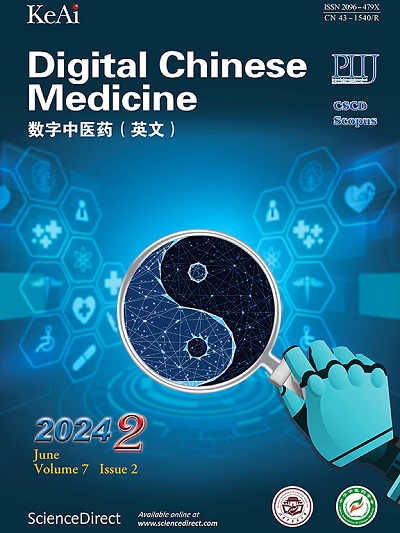山楂缓解tnbs诱导的大鼠溃疡性结肠炎:调节TNF-α/EGFR/STAT3/Bcl-2信号通路
Q3 Medicine
引用次数: 0
摘要
目的探讨枸杞子乙醇提取物(LCEE)对溃疡性结肠炎(UC)的治疗作用及其机制。方法采用定性分析、液相色谱-质谱联用(LC-MS)和高效薄层色谱(HPTLC)对LCEE进行植物化学分析。通过网络药理学分析鉴定出LCEE的有效成分,并进行分子对接。采用2,4,6-三硝基苯磺酸(TNBS)诱导的42只雄性Wistar大鼠(200 ~ 250 g)建立UC大鼠模型,验证其治疗机制。将大鼠随机分为7组(每组n = 6):正常对照组(NC)、乙醇对照组(EC)、疾病对照组(DC)、LCEE低剂量(100 mg/kg)、中剂量(200 mg/kg)、高剂量(400 mg/kg)、地塞米松组(DEX, 2 mg/kg, p / o)。在tnbs诱导UC (120 mg/kg,直肠内注射)后,大鼠口服治疗28 d。通过体重变化、疾病活动指数(DAI)、结肠重量、结肠长度和形态学评分评估疾病严重程度。测定血清和结肠组织中的血液学参数、酶促抗氧化剂、一氧化氮(NO)、髓过氧化物酶(MPO)和炎性细胞因子。采用定量逆转录聚合酶链式反应(qRT-PCR)分析肿瘤坏死因子(TNF)-α、表皮生长因子受体(EGFR)、转录信号传导和激活因子3 (STAT3)、b细胞淋巴瘤2 (Bcl-2)的基因表达。采用苏木精和伊红染色(HE)、吉姆萨染色和周期性酸希夫染色(PAS)评估结肠组织的组织病理学改变。结果薄层色谱-质谱分析鉴定出13种植物成分,HPTLC分析鉴定出熊果酸、京尼平苷和绿原酸。网络药理学分析确定了152个潜在的治疗靶点,其中TNF、STAT3、Bcl-2、白蛋白(ALB)和EGFR是前5个中心靶点。分子对接显示,LCEE植物成分与关键的炎症和凋亡靶点有很强的结合亲和力:linar苷与TNF-α (- 6.1 kcal/mol),熊果酸与STAT3 (- 6.8 kcal/mol)和Bcl-2 (- 8.7 kcal/mol),千里油与EGFR (- 8.2 kcal/mol),与DEX相当。LCEE治疗显著增加了体重和胸腺重量,同时显著降低了结肠重量、脾脏重量和DAI评分。血液学参数随着血红蛋白、红细胞和血小板计数的增加和白细胞计数的减少而显著改善。抗氧化指标随着谷胱甘肽、超氧化物歧化酶和过氧化氢酶水平的升高和丙二醛水平的降低而显著改善。与TNBS处理的大鼠相比,LCEE显著降低NO和MPO水平以及炎症因子TNF-α、白细胞介素(IL)-1β、核因子κ b (NF-κB)、IL-6和IL-12。LCEE下调TNF-α、EGFR和STAT3基因表达水平,上调Bcl-2基因表达水平,提示炎症和凋亡通路的调节。组织学评价证实,经LECC治疗后,粘膜溃疡和炎症细胞浸润减少。结论大戟属植物可作为缓解UC的药用植物,为大戟属植物的临床应用提供了研究依据。本文章由计算机程序翻译,如有差异,请以英文原文为准。
Lantana camara alleviating TNBS-induced ulcerative colitis in rats: regulating TNF-α/EGFR/STAT3/Bcl-2 signaling pathways
Objective
To investigate the therapeutic potential and underlying mechanism of Lantana camara ethanolic extract (LCEE) in ulcerative colitis (UC).
Methods
Phytochemical analysis of LCEE was conducted using qualitative analysis, liquid chromatography-mass spectrometry (LC-MS), and high-performance thin-layer chromatography (HPTLC). The active constituents of LCEE were identified through network pharmacology analysis, followed by molecular docking. The therapeutic mechanism was validated in a UC rat model using 42 male Wistar rats (200 – 250 g) induced by 2,4,6-trinitrobenzene sulfonic acid (TNBS). Rats were randomly divided into seven groups (n = 6 per group): normal control (NC), ethanol control (EC), disease control (DC), three doses of LCEE treatment [low dose LCEE (100 mg/kg), medium dose LCEE (200 mg/kg), and high dose LCEE (400 mg/kg), p.o.], and dexamethasone (DEX, 2 mg/kg, p.o.) groups. Following TNBS-induced UC (120 mg/kg, intrarectally), rats were treated orally for 28 d. Disease severity was assessed through body weight changes, disease activity index (DAI), colon weight, colon length, and morphological scores. Haematological parameters, enzymatic antioxidants, nitric oxide (NO), myeloperoxidase (MPO), and inflammatory cytokines were measured in the serum and colon tissues. Gene expressions of tumor necrosis factor (TNF)-α, epidermal growth factor receptor (EGFR), signal transducer and activator of transcription 3 (STAT3), and B-cell lymphoma 2 (Bcl-2) were analyzed by quantitative reverse transcription polymerase chain reaction (qRT-PCR). Histopathological alterations in the colon tissues were evaluated using hematoxylin and eosin (HE), Giemsa, and periodic acid-schiff staining (PAS).
Results
LC-MS analysis identified 13 phytoconstituents in LCEE, and HPTLC analysis confirmed the presence of ursolic acid, geniposide, and chlorogenic acid. Network pharmacological analysis identified 152 potential therapeutic targets with TNF, STAT3, Bcl-2, albumin (ALB), and EGFR as the top 5 hub targets. Molecular docking revealed strong binding affinities of LCEE phytoconstituents with key inflammatory and apoptotic targets: linaroside with TNF-α (– 6.1 kcal/mol), ursolic acid with STAT3 (– 6.8 kcal/mol) and Bcl-2 (– 8.7 kcal/mol), and cirsiliol with EGFR (– 8.2 kcal/mol), comparable to DEX. LCEE treatment significantly increased body weights and thymus weight, while significantly reducing colon weight, spleen weight, and DAI scores. Haematological parameters showed significant improvements with increased haemoglobin, red blood cells, and platelet count, and decreased white blood cells counts. Antioxidants markers were significantly improved with increased glutathione, superoxide dismutase, and catalase levels, and decreased malondialdehyde levels. LCEE significantly reduced NO and MPO levels and inflammatory cytokines including TNF-α, interleukin (IL)-1β, nuclear factor kappa-B (NF-κB), IL-6, and IL-12 compared with TNBS treated rats. LCEE downregulated the gene expression levels of TNF-α, EGFR, and STAT3, while upregulating Bcl-2 expression level, indicating modulation of inflammation and apoptosis pathways. Histological evaluation confirmed that after LECC treatment, mucosal ulcers and inflammatory cell infiltration decreased.
Conclusion
The findings suggest that Lantana camara may serve as a medicinal plant to alleviate UC and offer an investigational basis for the clinical utilization of Lantana camara.
求助全文
通过发布文献求助,成功后即可免费获取论文全文。
去求助
来源期刊

Digital Chinese Medicine
Medicine-Complementary and Alternative Medicine
CiteScore
1.80
自引率
0.00%
发文量
126
审稿时长
63 days
期刊介绍:
 求助内容:
求助内容: 应助结果提醒方式:
应助结果提醒方式:


